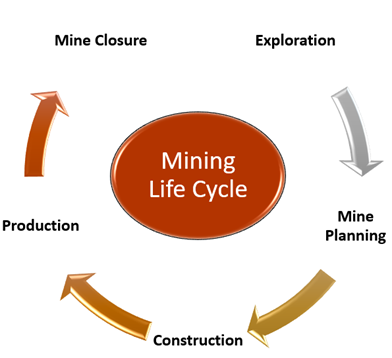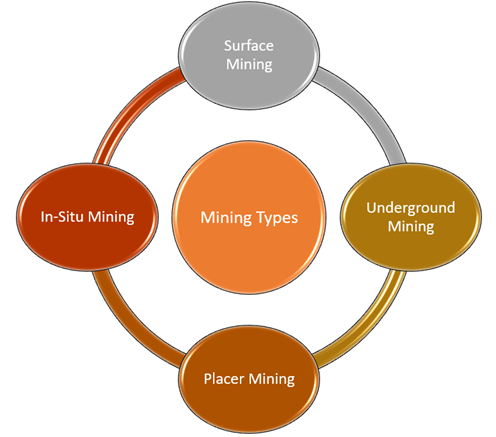Mining is the process of extraction of valuable ores from the surface of the Earth. The ore bodies contain a significant amount of minerals that can be recovered from ores and processed for commercial interests. In simpler words, one can say that mining is the process of digging valuable metals and minerals like coal, gold, silver, diamond, iron, copper, tin, etc., from the surface.
Life Cycle of a Mine:
The life cycle of mining incorporates five incredible components ranging from exploration to closure. The process of mining starts with the exploration phase, proceeds to the production or mining phase, and ends with the mine closure. Let us try to understand all the phases involved in the mining process in brief.

Copyright © 2021 Kalkine Media Pty Ltd
- Exploration: It is the most basic and foremost step in the lifecycle of a mining project. Every mining project starts with this phase. Companies hire geologists to understand the prospects of an area in search of mineral deposits. Geologists use various techniques like mapping, sampling, and geophysical surveys to understand the particular area's geological significance and delineate the mineral prospects. Geophysical surveys help geologists to identify the drill targets.
- Mine Planning: The second stage that comes into the picture is the Mine planning stage. After the completion of mapping and estimation of resources, if the company proceeds further accounting, the project's economic feasibility, designing, and planning of the mine commence. The company evaluates and explores different options to identify the best possible way to further developing the mine. This helps the miner to carry out the project in the most economical, social, and eco-friendly manner.
- Construction: After the completion of the planning phase and taking necessary regulatory approvals along with other technical aspects of the project, the construction phase starts. However, the type of construction entirely depends on the type of mineral to be mined and the scope and size of the project. Construction of roads, housing facility, processing facility are parts of this step.
- Production: After the completion of the construction phase, the company finally enters into the production stage. The production stage contains three main steps. The first stage involves the recovery of minerals from the corresponding ores using various techniques, tools, and equipment. The second step incorporates the processing of recovered minerals from ore bodies using high-end mills and crushers to segregate commercial minerals from their ores. The final step involves the transportation of ore to a smelting facility where the separated ore is melted in huge furnaces to extract valuable minerals.
- Mine Closure: After successfully recovering economic deposits from the mine, the operations finally come to an end. All the mining activities are abandoned at this stage, and companies formulate plans to abandon the mine in an eco-friendly manner. Miners undertake detailed environmental studies to close the mine and rehabilitate the mining area.
Types of Mining:
There are four major types of mining techniques widely used in the industry. The use of a particular technique strictly depends on the scope of the project and the mineral to be mined. Let us have a brief idea about all four types of mining techniques.

Copyright © 2021 Kalkine Media Pty Ltd
- Surface Mining: This mining technique is used for the extraction of shallow and relatively less valuable deposits. About 67 per cent of the minerals mined in the world come from surface mining. The process involves the removal of soil and bedrock to access the mineral deposits. There are numerous types of surface mining techniques under this category like open-pit mining, quarrying, and strip mining which are extensively used in the industry for the extraction of minerals.
Open-pit mining involves digging an open pit or borrow pit by removing out rocks. To minimise the risk of collapse, open-pits are dug in the form of steps. Strip mining is mainly done to extract thin, flat deposits of coal. Quarrying is mainly used to extract the granite, marble, slate, and other stones, which are high values for their precious appearance.
- Underground Mining: Underground mining is relatively more expensive than every other mining technique and is generally used for deeper deposits. Due to the deeper depth of deposited minerals, it becomes impossible to extract the minerals with surface mining techniques. The cost of mining of each ton of material is significantly higher than surface mining whereas the productivity lies 5-50 times lower in this case. Underground tunnels are dug to reach the source of deposits.
- Placer mining: This type of mining technique is used to extract valuable metals from beach sands, river channel sediments, other environments. Placers are unconsolidated deposits that are formed by the weathering action of water or wind action. Around half of the world's titanium is extracted from placer mining. This technique also extracts other precious metals like gold, platinum, tin, and gemstones.
- In-situ mining: In-situ mining involves the dissolution of a mineral at the in-situ site and then processing it at the surface. The process involves pumping chemicals underground to dissolve the ore and then bring it to the surface by pumping pregnant solution, to process it further for the extraction of minerals. The technique is widely used in uranium mining. The technique is sometimes referred to as solution mining.
Effects of Mining on Environment:
Mining is exceptionally dangerous to the climate. It is one of the fundamental reasons for deforestation. Before the execution of mining, vegetation is cleared from the ground. The mining process involves mega-size tractors, trucks, and processing units to carry and separate the metals and minerals from their ores. The amalgamation of extracts involves different types of chemical compounds like mercury, cyanide, and methylmercury. These synthetic compounds go through tailings and are regularly released into natural waterways like rivers, which ultimately enter the ocean and seas. This contamination of these chemicals ultimately enters into the food cycle and affects all living organisms' health, including human beings. In addition to that, mining activities also enhance air pollution and degrades the quality of the land.
 Please wait processing your request...
Please wait processing your request...